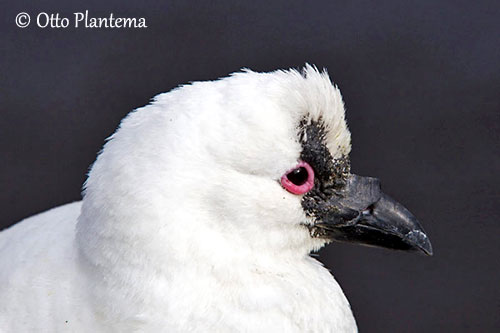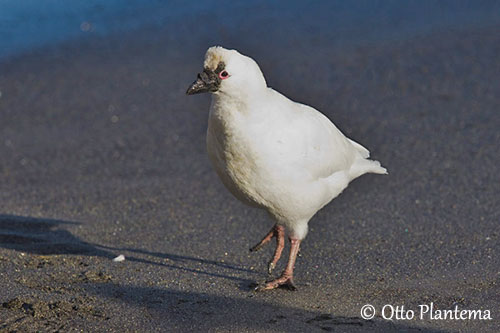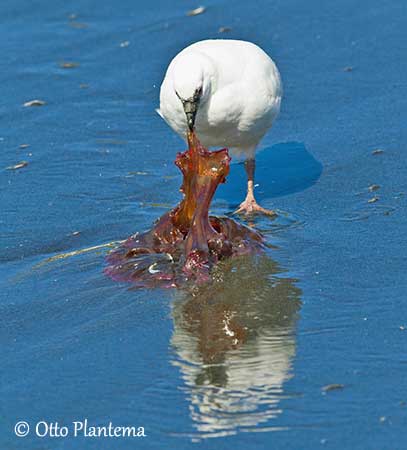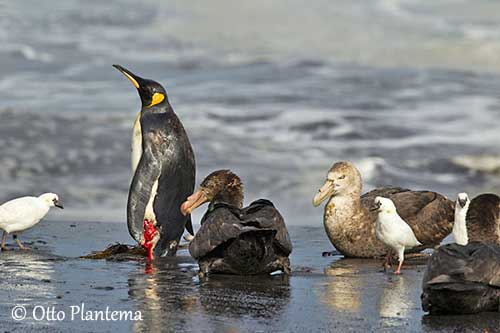
Fr: Petit Chionis
All: Schwarzgesicht-Scheidenschnabel
Esp: Picovaina de las Kerguelen
Ita: Chione minore
Nd: Klein IJshoen
Sd: Mindre slidnäbb
Photographer:
Otto Plantema
Trips around the world
Text by Nicole Bouglouan
Sources:
HANDBOOK OF THE BIRDS OF THE WORLD Vol 3 by Josep del Hoyo-Andrew Elliott-Jordi Sargatal - Lynx Edicions - ISBN : 8487334202
L’ENCYCLOPEDIE MONDIALE DES OISEAUX - Dr Christopher M. Perrins - BORDAS - ISBN: 2040185607
BirdLife International (BirdLife International)
Department of Sustainability, Environment, Water, Population and Communities
Welcome to the UVic Seabird & Murrelet Research Group
Black-faced Sheathbill
Chionis minor
Charadriiformes Order – Chionidae Family
INTRODUCTION:
The Black-faced Sheathbill is the second member of the family Chionidae. It is found in the sub Antarctic islands, living among penguins and giant petrels. It is a terrestrial scavenger, often seen close to petrels around carcasses or still living injured animals.
DESCRIPTION OF THE BIRD:
Biometrics:
Length: 38-41 cm
Wingspan: 74-79 cm
Weight: 450-760 g
The adult has white plumage overall. It develops blunt, black carpal spurs, used during aggressive encounters.
The bill, bill sheath and facial pattern are black. The eyes are dark brown, surrounded by pink eyering. Legs and feet vary according to the subspecies, ranging from pink to dark purplish.
Both sexes are similar, with male slightly larger than female.
The juvenile has smaller bill sheath and eyering. The immature has darker legs and feet.

SUBSPECIES AND RANGE:
There are four subspecies forming two groups: the eastern group (Kerguelen and Heard) and the western group (Prince Edward, Marion and Crozet Is).
C.m. minor (here described) occurs on Kerguelen Is.
C.m. nasicornis is found on Heard and Mac Donald Is. This one is very similar to nominate. It has shorter culmen, but larger bill sheath and tarsus.
Both races are larger and heavier than the following western subspecies.
C.m. marionensis occurs on Marion and Prince Edward Is.
C.m. crozettensis is found on Crozet I.
Both are slightly smaller than eastern races, with smaller bill sheath and more prominent, larger caruncles.

HABITAT:
The Black-faced Sheathbill is usually found in colonies of Spheniscidae such as Rockhopper, Macaroni and King Penguins. It feeds with other seabirds, cormorants and albatrosses, on rocky and sandy beaches. It may frequent meadows, inland bogs and tussock grass close to the shore, but it is also visible around human settlements.
CALLS AND SONGS: SOUNDS BY XENO-CANTO
The Black-faced Sheathbill is usually silent like the Snowy Sheathbill, but we can hear short rattling croaks “kek, kek, kek, kek…”. The largest races have lower-pitched voice.
BEHAVIOUR IN THE WILD:
The Black-faced Sheathbill feeds on varied food items. It often steals marine preys from penguins (squid and others), and takes their eggs and small chicks too. It also feeds on carrion, faeces of seabirds and marine mammals, and placentae, blood and milk of seals. When this type of food is not available, it takes invertebrates and algae.
However, during winter, it feeds on terrestrial invertebrates such as earthworms, insects and spiders, found in inland bogs and meadows.

The Black-faced Sheathbill shows strong fidelity to its territory and nest-site, and also to its mate. They are monogamous.
Some displays are reported such as “bowing ceremony” during which both mates bow their heads up and down while calling “kek, kek, kek…”. These displays take usually place within the territory.
This display is also used as greeting display, or in response to intruders. The territory is defended by both sexes, although the male is often more aggressive. Intruders are warned off with loud calls. The male adopts a “forwards” posture like gulls. But the intruder can be chased too, by running, flying or flapping run.
Some fights may occur, during which opponents face each other in upright posture, with slightly open wings to expose the black carpal spurs.
The Black-faced Sheathbill is sedentary but some movements within the archipelago are related to food availability.
The flight is strong and direct, with continuous wingbeats and occasional glides.
REPRODUCTION OF THIS SPECIES:
The breeding season is linked with that of penguins and other colonial seabirds.
The nest is usually hidden within crevice, in small cave or petrel burrow, or behind overhanging rock. This is a cup placed on top of untidy smelly pile of tussock grass, moss, algae, feathers and old bones and debris. The nest is protected from skuas and bad weather, and penguin’s colonies may also provide more protection against predators.

The female lays 2-3 creamy-white eggs with grey and brown markings. Both sexes incubate during 28-32 days. At hatching, the chicks have dense brown down, and later, a coat of mottled grey down.
They are fed by both adults, but they do not regurgitate. The young birds leave the nest one month later and are able to forage alone, but they still depend on parents for food for up to six months. They can breed at 3-5 years old.
PROTECTION / THREATS / STATUS:
The Black-faced Sheathbill’s population is suspected to be declining due to predation by invasive species (feral cats). The population size is estimated to 8,700/13,000 mature individuals.
But in spite of some declines, the species is not currently threatened.